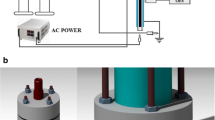Abstract
In this paper, degradation of selected organophosphate pesticides (dichlorvos and dimethoate) in wastewater by dielectric barrier discharge plasma (DBD) was studied. DBD parameters, i.e. discharge powers and air-gap distances, differently affect their degradation efficiency. The results show that better degradation efficiency is obtained with a higher discharge power and a shorter air-gap distance. The effect of radical intervention degradation was also investigated by adding radical scavenger (tert-butyl alcohol) to the pesticide solution during the experiments. The result shows that the degradation efficiency is restrained in the presence of radical scavenger. It clearly demonstrates that hydroxyl radicals are most likely the main driver for degradation process. Moreover, the kinetics indicate that the disappearance rate of pesticides follows the first-order rate law when the initial concentration of the solution is low, but shifts to zero-order at a higher initial concentration.






Similar content being viewed by others
References
Acero JL, Real FJ, Benitez FJ, Gonzalez A (2008) Oxidation of chlorfenvinphos in ultrapure and natural waters by ozonation and photochemical processes. Water Res 42:3198–3206
Bai YH, Chen JR, Mu H, Zhang CH, Li BP (2009) Reduction of dichlorvos and omethoate residue by O2 plasma treatment. J Agric Food Chem 57:6238–6245
Bai YH, Chen JR, Yang Y, Guo LM, Zhang CH (2010) Degradation of organophosphorus pesticide induced by oxygen plasma: effects of operating parameters and reaction mechanisms. Chemosphere 81:408–414
Buxton GV, Greenstock CL, Helman WP, Ross AB (1988) Critical review of rate constants for reactions of hydrated electrons, hydrogen atoms and hydroxyl radicals (·OH/·O−) in aqueous solution. J Phys Chem Ref Data 17:513–886
Chen RH, Ling DH, Duan XF (2011) Simultaneous determ ination of 10 organophosphorus pesticides in fruit juices by HPLC. Chin J Health Lab Technol 21:854–855 858
Dogan D, Can C, Kocyigit A, Dikilitas M, Taskin A, Bilinc H (2011) Dimethoate-induced oxidative stress and DNA damage in Oncorhynchus mykiss. Chemosphere 84:39–46
Feng JW, Zheng Z, Sun YB, Luan JF, Wang Z, Wang LH, Feng JF (2008) Degradation of diuron in aqueous solution by dielectric barrier discharge. J Hazard Mater 154:1081–1089
Gilliom RJ (2007) Pesticides in US streams and groundwater. Environ Sci Technol 41:3408–3414
Hong F, Win KY, Pehkonen SO (2001) Hydrolysis of terbufos using simulated environmental conditions: rates, mechanisms, and product analysis. J Agric Food Chem 49:866–873
Huang FM, Chen L, Wang HL, Feng TZ, Yan ZC (2012) Degradation of methyl orange by atmospheric DBD plasma: analysis of the degradation effects and degradation path. J Electrost 70:43–47
Kim SH, Kim JH, Kang BK (2007) Degradation reaction of organophosphorus nerve agents on solid surfaces with atmospheric radio frequency plasma generated gaseous species. Langmuir 23:8074–8078
Li YY, Hong HS, Wang XH, Hong LY, Ye CX (2005) Estimation of the sources of organophosphorus pesticides in Xiamen sea area. Acta Sci Circumst 25:1071–1077
Li RX, Yang CP, Chen H, Zeng GM, Yu GL, Guo JY (2009) Removal of triazophos pesticide from wastewater with Fenton reagent. J Hazard Mater 167:1028–1032
Lou J, Lu N, Li J, Wang TC, Wu Y (2012) Remediation of chloramphenicol-contaminated soil by atmospheric pressure dielectric barrier discharge. Chem Eng J 180:99–105
Lu C, Barr DB, Pearson MA, Waller LA (2008) Dietary intake and its contribution to longitudinal organophosphorus pesticide exposure in urban/suburban children. Environ Health Perspect 116:537–542
Lu N, Li J, Wang XX, Wang TC, Wu Y (2012) Application of double-dielectric barrier discharge plasma for removal of pentachlorophenol from wastewater coupling with activated carbon adsorption and simultaneous regeneration. Plasma Chem Plasma Process 32:109–121
Mok YS, Jo JO, Whitehead JC (2008) Degradation of an azo dye Orange II using a gas phase dielectric barrier discharge reactor submerged in water. Chem Eng J 142:56–64
Oancea P, Oncescu T (2008) The photocatalytic degradation of dichlorvos under solar irradiation. J Photochem Photobiol A Chem 199:8–13
Peyrous R, Pignolet P, Held B (1989) Kinetic simulation of gaseous species created by an electrical discharge in dry or humid oxygen. J Phys D Appl Phys 22:1658–1667
Romero-Navarro G, Lopez-Aceves T, Rojas-Ochoa A, Mejia CF (2006) Effect of dichlorvos on hepatic and pancreatic glucokinase activity and gene expression, and on insulin mRNA levels. Life Sci 78:1015–1020
Tomizawa S, Tezuka M (2007) Kinetics and mechanism of the organic degradation in aqueous solution irradiated with gaseous plasma. Plasma Chem Plasma Process 27:486–495
Wang L, Li XC, Yin YF, Xu XQ, Zhou WH, Wang XR (2008) Environmental behavior and risk assessment of organic phosphorus pesticides at water from Jiaozhou Bay. Toxic chemical pollutants monitoring and risk management technology exchange conference, Changsha City, Hunan Province, China
Xu W (2000) Determination of residual amount of 8 kinds of pesticides in environmental water by high liquid chromatography. J Environ Health 17:362–363
Zhang JB, Zheng Z, Zhang YN, Feng JW, Li JH (2008) Low-temperature plasma-induced degradation of aqueous 2,4-dinitrophenol. J Hazard Mater 154:506–512
Zhao J, Chen JR, Gao J (2010) Decolorization of azo dyes C.I.acid yellow 17 and C.I.direct red 31 by dielectric-barrier discharge air plasma. IEEE Trans Plasma Sci 38:488–495
Acknowledgments
This work was supported by the National Natural and Science Foundation of China under Grants 30571636 and 20877062. We thank Prof. Hui Mu, Dr. Xiaoyong Li, and senior engineer Yun Yang for their technical guidance. We also thank Dr. Dongmei Lu for her help to modify the paper in English language. We would also like to express our gratitude to our reviewers and editors, who gave us helpful comments and edits for improving the paper.
Author information
Authors and Affiliations
Corresponding author
Rights and permissions
About this article
Cite this article
Hu, Y., Bai, Y., Yu, H. et al. Degradation of Selected Organophosphate Pesticides in Wastewater by Dielectric Barrier Discharge Plasma. Bull Environ Contam Toxicol 91, 314–319 (2013). https://doi.org/10.1007/s00128-013-1048-x
Received:
Accepted:
Published:
Issue Date:
DOI: https://doi.org/10.1007/s00128-013-1048-x




